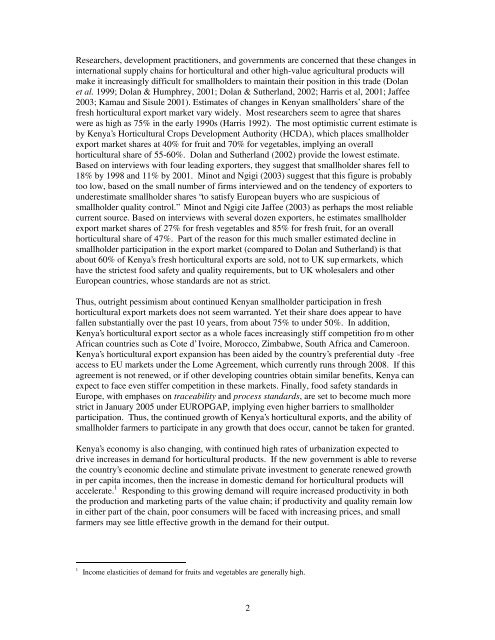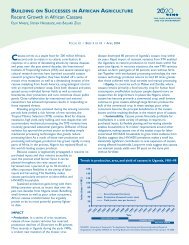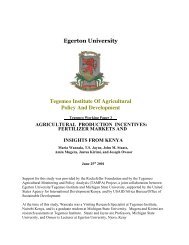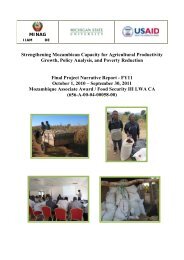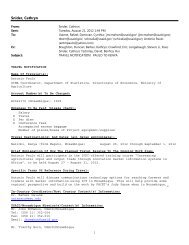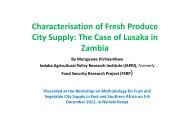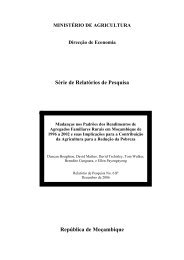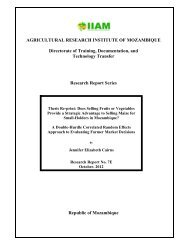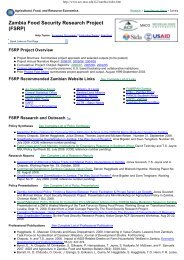Improving Kenya's Domestic Horticultural Production and Marketing
Improving Kenya's Domestic Horticultural Production and Marketing
Improving Kenya's Domestic Horticultural Production and Marketing
You also want an ePaper? Increase the reach of your titles
YUMPU automatically turns print PDFs into web optimized ePapers that Google loves.
Researchers, development practitioners, <strong>and</strong> governments are concerned that these changes in<br />
international supply chains for horticultural <strong>and</strong> other high-value agricultural products will<br />
make it increasingly difficult for smallholders to maintain their position in this trade (Dolan<br />
et al. 1999; Dolan & Humphrey, 2001; Dolan & Sutherl<strong>and</strong>, 2002; Harris et al, 2001; Jaffee<br />
2003; Kamau <strong>and</strong> Sisule 2001). Estimates of changes in Kenyan smallholders’ share of the<br />
fresh horticultural export market vary widely. Most researchers seem to agree that shares<br />
were as high as 75% in the early 1990s (Harris 1992). The most optimistic current estimate is<br />
by Kenya’s <strong>Horticultural</strong> Crops Development Authority (HCDA), which places smallholder<br />
export market shares at 40% for fruit <strong>and</strong> 70% for vegetables, implying an overall<br />
horticultural share of 55-60%. Dolan <strong>and</strong> Sutherl<strong>and</strong> (2002) provide the lowest estimate.<br />
Based on interviews with four leading exporters, they suggest that smallholder shares fell to<br />
18% by 1998 <strong>and</strong> 11% by 2001. Minot <strong>and</strong> Ngigi (2003) suggest that this figure is probably<br />
too low, based on the small number of firms interviewed <strong>and</strong> on the tendency of exporters to<br />
underestimate smallholder shares “to satisfy European buyers who are suspicious of<br />
smallholder quality control.” Minot <strong>and</strong> Ngigi cite Jaffee (2003) as perhaps the most reliable<br />
current source. Based on interviews with several dozen exporters, he estimates smallholder<br />
export market shares of 27% for fresh vegetables <strong>and</strong> 85% for fresh fruit, for an overall<br />
horticultural share of 47%. Part of the reason for this much smaller estimated decline in<br />
smallholder participation in the export market (compared to Dolan <strong>and</strong> Sutherl<strong>and</strong>) is that<br />
about 60% of Kenya’s fresh horticultural exports are sold, not to UK sup ermarkets, which<br />
have the strictest food safety <strong>and</strong> quality requirements, but to UK wholesalers <strong>and</strong> other<br />
European countries, whose st<strong>and</strong>ards are not as strict.<br />
Thus, outright pessimism about continued Kenyan smallholder participation in fresh<br />
horticultural export markets does not seem warranted. Yet their share does appear to have<br />
fallen substantially over the past 10 years, from about 75% to under 50%. In addition,<br />
Kenya’s horticultural export sector as a whole faces increasingly stiff competition fro m other<br />
African countries such as Cote d’ Ivoire, Morocco, Zimbabwe, South Africa <strong>and</strong> Cameroon.<br />
Kenya’s horticultural export expansion has been aided by the country’s preferential duty -free<br />
access to EU markets under the Lome Agreement, which currently runs through 2008. If this<br />
agreement is not renewed, or if other developing countries obtain similar benefits, Kenya can<br />
expect to face even stiffer competition in these markets. Finally, food safety st<strong>and</strong>ards in<br />
Europe, with emphases on traceability <strong>and</strong> process st<strong>and</strong>ards, are set to become much more<br />
strict in January 2005 under EUROPGAP, implying even higher barriers to smallholder<br />
participation. Thus, the continued growth of Kenya’s horticultural exports, <strong>and</strong> the ability of<br />
smallholder farmers to participate in any growth that does occur, cannot be taken for granted.<br />
Kenya’s economy is also changing, with continued high rates of urbanization expected to<br />
drive increases in dem<strong>and</strong> for horticultural products. If the new government is able to reverse<br />
the country’s economic decline <strong>and</strong> stimulate private investment to generate renewed growth<br />
in per capita incomes, then the increase in domestic dem<strong>and</strong> for horticultural products will<br />
accelerate. 1 Responding to this growing dem<strong>and</strong> will require increased productivity in both<br />
the production <strong>and</strong> marketing parts of the value chain; if productivity <strong>and</strong> quality remain low<br />
in either part of the chain, poor consumers will be faced with increasing prices, <strong>and</strong> small<br />
farmers may see little effective growth in the dem<strong>and</strong> for their output.<br />
1 Income elasticities of dem<strong>and</strong> for fruits <strong>and</strong> vegetables are generally high.<br />
2


